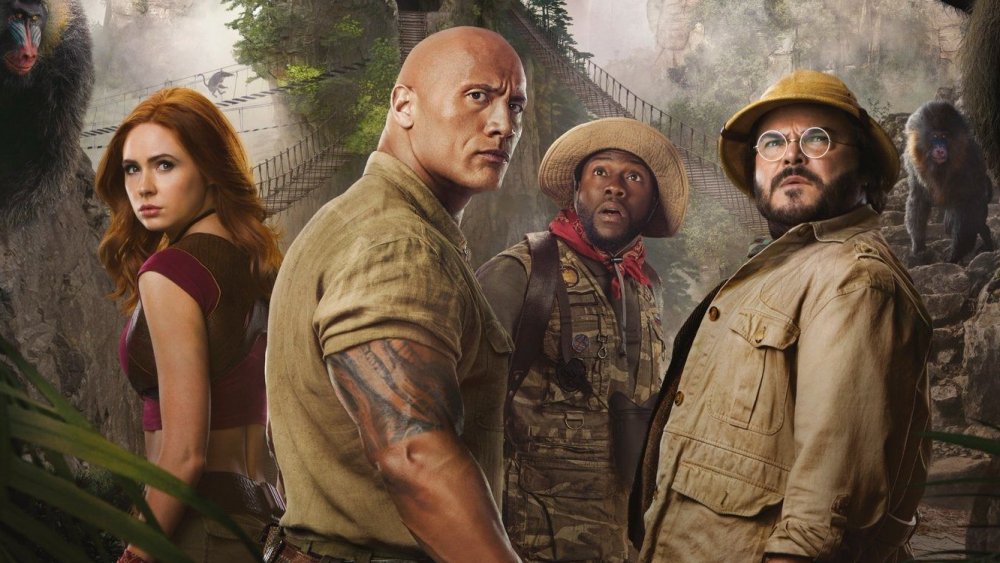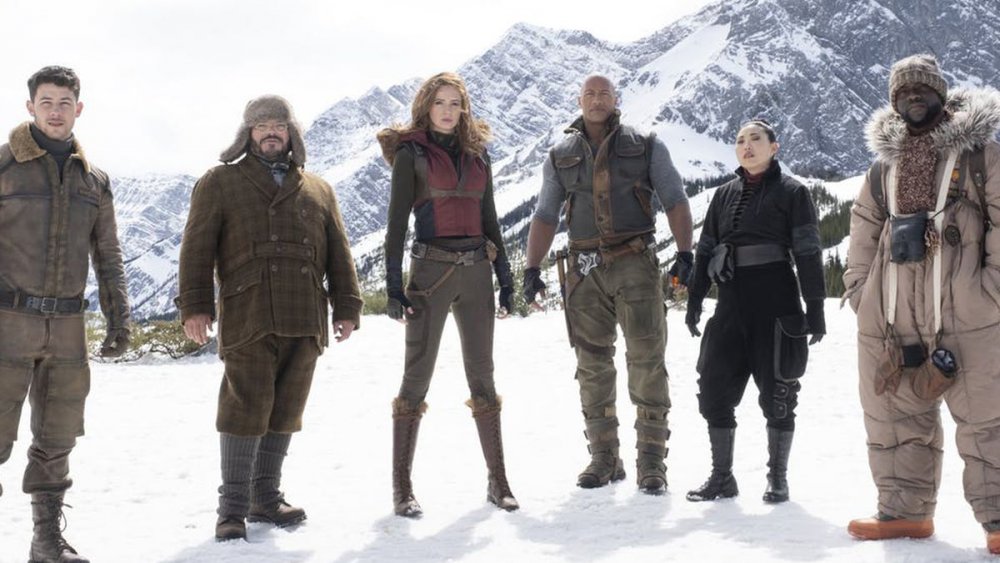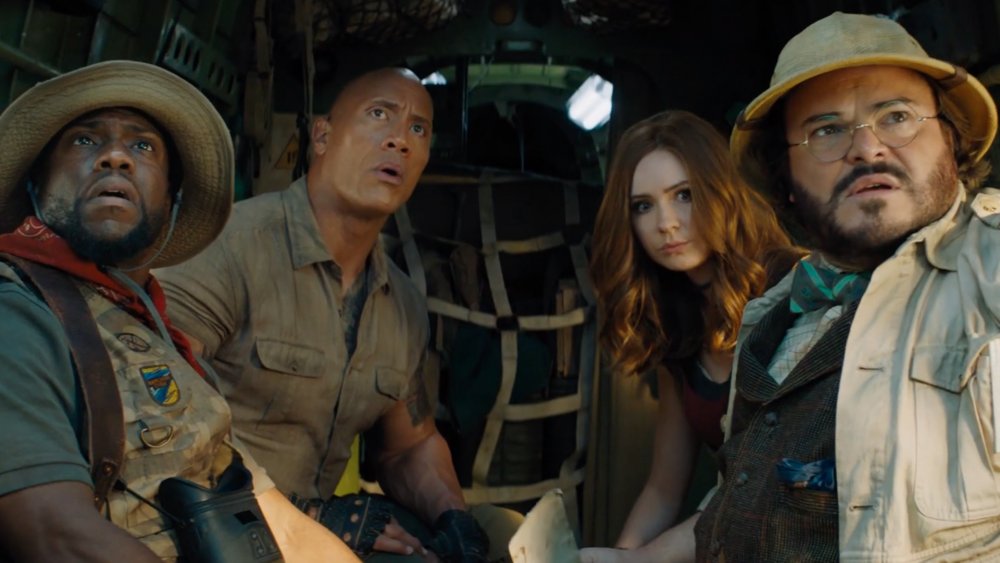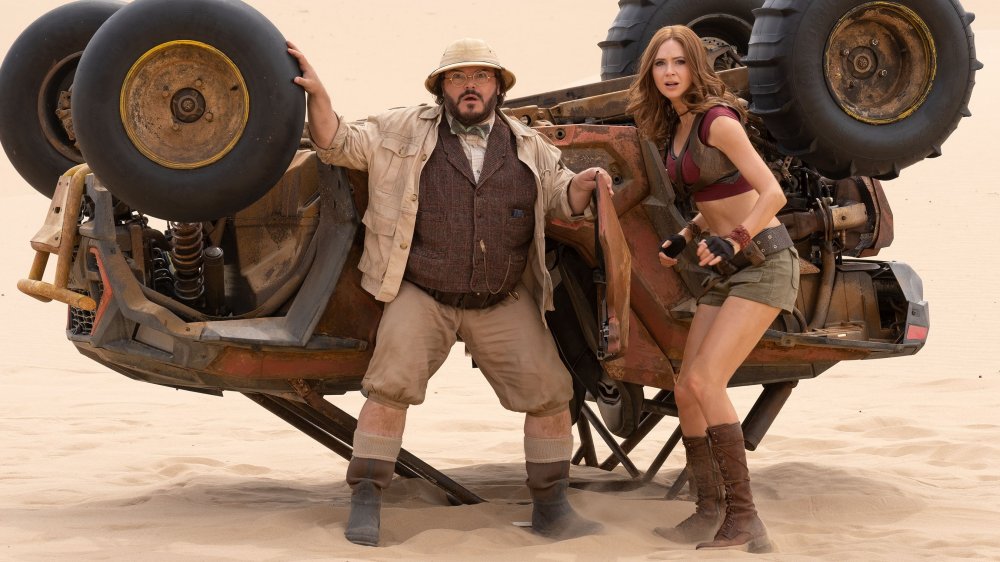What It Really Took To Create The Video Game World In Jumanji: The Next Level - Exclusive
In 2017, moviegoers were well and truly impressed by Jumanji: Welcome to the Jungle, the Jake Kasdan-directed action-fantasy-comedy feature that aimed to follow up the 1995 classic Jumanji with a fresh twist that wouldn't turn the burgeoning franchise in on itself but rather out toward continued success. The film opened to warm reviews and a booming box office, with audiences and critics alike getting swept up in the story of a group of teenagers stuck inside a video game. Welcome to the Jungle proved such a critical and commercial hit that Sony Pictures found ordering a sequel a wise move, and thus 2019's Jumanji: The Next Level was born.
Set three years after the events of Welcome to the Jungle, The Next Level lives up to its title by kicking things up several notches in more respects than one. The film expanded its cast — adding Awkwafina as expert thief Ming Fleetfoot; Rory McCann as the warlord Jurgen the Brutal; Danny DeVito as Eddie Gilpin, the grandfather to Alex Wolff's Spencer Gilpin; and Danny Glover as Milo Walker, a friend of Eddie's — and built out its in-universe video game world in exciting fashion.
Looper had the chance to speak with Jumanji: The Next Level production designer Bill Brzeski, who opened up about what it really took to create the film's video game world.
Creating the sets for Jumanji: The Next Level
When it comes to film production and design, there's always a conversation of whether to use physical sets and effects and rely on CGI for any additions, or to build entirely digital sets. In the case of Jumanji: The Next Level, Brzeski revealed that "it was mostly practical" in the sense that sets were built and then expanded upon digitally. "Especially the effects and explosions and all that kind of stuff are more handled in the digital sense now," he noted, adding that it's becoming more common to rely on digital sets and CGI given that technology is improving.
Brzeski then explained that that The Next Level went "full-on video game mode," which meant more locations that would comprise its world as compared to Welcome to the Jungle. "We start the jungle for, like, one scene. We get picked up in an airplane, then we're in the desert, then we're in mountains, then we're in snow.Then we're in water, then we're fighting Vikings. We were in an oasis. It's a really big movie," he shared.
To craft so many locations for the film's video game world, Brzeski and the film's production team went to various different places to shoot scenes and pick up inspiration for sets. "We went out to Shiprock, New Mexico. I had an opportunity to scout anywhere I wanted to go in the country [...] so we went out to some really crazy places. Out in Four Corners, they found some great monuments," said Brzeski. "Then we went to Calgary and up in the mountains there, and then we shot in the Glamis Dunes in the deserts of Southern California. So it was a big road trip. And onstage we built some rather large sets."
Jumanji: The Next Level implemented conventions of real-life video games
Of course, there's more to crafting an expansive, exhilarating video game world for a film than just perfecting the way it looks. As Brzeski told us, it was important that Jumanji: The Next Level used "the conventions of video games" within its game universe, as it made the film feel more immersive.
"The characters are avatars and they have their hang-ups. They operate a certain way every time, and they have their strengths and weaknesses [...] and so they have those issues that they have to work their way through. We keep the rules going very strong," he said. "We have the convention that [characters] can only be killed three times and then you're killed for good in the Jumanji world. So it still plays into the game."
Brzeski then noted that he and the Next Level team — and his daughter, who works for game developer and publisher Blizzard Entertainment — had discussions about how far to take "the game rules" and how certain things in the movie would play out in actual video games.
"We think about that — what would happen with a video game in a fight? So where it really gets involved is in stunts and action, [which] can be video game-ish. Things can blow up, you don't necessarily get killed if you get hit by a bomb, if you punch a guy, you can punch a guy through a wall — that kind of stuff that you get in a video game. So that gives you that superhero aspect of the whole thing," he said. "Since I've done a lot of action, it's kind of been my bread and butter in my career, blowing stuff up and crashing cars and all that [...] and we always tried to figure out [a] more exciting way of doing it."
Striking the right balance with Jumanji: The Next Level's video game world
When dealing with fantastical, exaggerated in-movie worlds like the video game universe of Jumanji: The Next Level, it's crucial to keep things grounded and relatable for the audience. Brzeski described that as "the trick to any good production design," and revealed that there was a lot that went into striking the perfect balance with the film.
"You have to keep it real enough that people understand what's in the space as being real so that maybe they're a little confused by what's going on, but they know [characters] could die. And almost any of these kinds of movies, they set up the parameters that people can be killed," explained Brzeski, adding that problems arise when characters are too difficult to kill or "there's no jeopardy" at hand in the in-film world.
"We tried very much to make it look as real as possible. I went way out of my way on this one especially. I have a great decorator, Danielle Berman, and she worked very hard to make our set pieces in Jumanji to be just like real, real — so you felt like there was jeopardy, that you really could drown, you could really be killed," he continued. "That's my whole thing of production design: the more real it looks, the more a willing suspension of belief goes away [...] so you could actually pull somebody into a project."
By the looks of it — with glowing reviews and big box office bucks behind it – Jumanji: The Next Level succeeded in its every endeavor, undoubtedly due in part to the decisions Brzeski and co. made behind the scenes.



